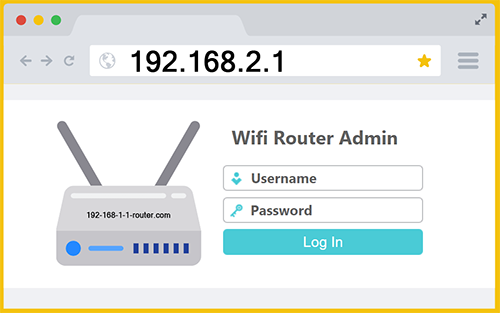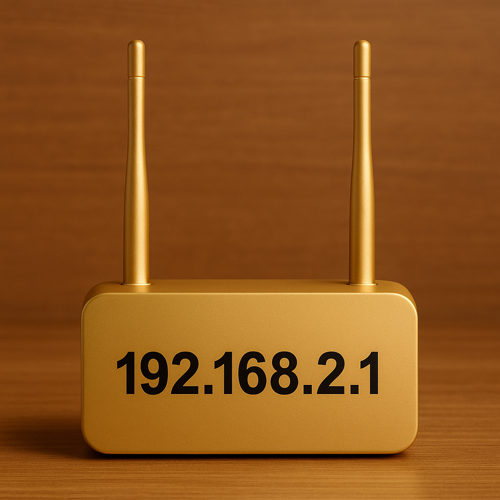192.168.2.1
 Guide to 192.168.2.1 Admin Login
Guide to 192.168.2.1 Admin Login
The IP address 192.168.2.1 is frequently assigned as the default gateway for many routers, acting as the entry point to the device’s admin panel. This local address gives users direct access to a web-based control center where they can configure their Wi-Fi network. From there, it’s easy to change the network name, set a new password, adjust security settings, view connected devices, and optimize performance settings to ensure smooth and reliable connectivity throughout the home.
How to Use 192.168.2.1 Admin

To control your router’s settings, start by making sure your device is connected to the router’s network. Then, launch any web browser and enter “192.168.2.1” into the address bar (don’t use the search box). This should bring up a login page prompting you for a username and password. You’ll find the defaults below. Once signed in, you can customize your Wi-Fi settings such as renaming your network, updating the password, or adjusting security preferences. You can also jump straight to the login page by clicking this link:
Typical username: admin
Typical password: admin or password
If you enter https://192.168.2.1 into Google’s search bar instead of typing it directly into your web browser’s address bar, the search engine will interpret it as an ordinary query rather than a specific web address. As a result, rather than being directed to your router’s administrative login page, you’ll be presented with a list of online search results related to the IP address. This happens because search engines are intrinsically designed to assume you’re seeking online information, not initiating a direct connection to a local network device. To avoid this common misstep, it’s essential to use the browser’s URL field, which correctly processes the IP as a local gateway and facilitates immediate access to your router’s configuration portal. Misrouting this input is a frequent yet easily avoidable oversight that can hinder timely router administration.
Why is 192.168.2.1 Important?
The IP address 192.168.2.1 is a private IPv4 address often employed as the default gateway for a variety of home broadband routers. It acts as the central access point to the router’s administrative console, where users can manage critical network functions. Unlike public IP addresses, 192.168.2.1 is reserved exclusively for use within local area networks (LANs), meaning it cannot be accessed from outside your home or office network. This address allows users to interface directly with their router’s firmware through a web browser, enabling configuration of Wi-Fi settings, parental controls, port forwarding, and firewall rules – all from one centralized dashboard.
Numerous router manufacturers assign 192.168.2.1 as the default login IP on specific models. Belkin is perhaps the most prominent brand known for using this address across a wide range of their consumer routers. Other manufacturers like Edimax, Zyxel, and some models from SMC Networks also utilize this IP, depending on the firmware and regional configuration. These brands choose 192-168-2-1 in part to avoid conflicts with more commonly used IPs like 192 .168.1.1 or 192.168.01, offering a slightly more isolated and interference-free setup experience for users in densely populated wireless environments.
Several popular routers utilize 192 168 2 1 as their default administrative gateway, streamlining user access to network management. Renowned models include the Belkin N600 DB Wireless Router, praised for its intuitive setup and reliable dual-band connectivity; the sleek and efficient Belkin AC1200 DB Router, recognized for robust signal strength and speed; and the Edimax BR-6428nS, favored for its user-friendly interface and compact design. Additionally, the SMC Networks Barricade SMC7004VWBR stands out for seamless configuration and exceptional performance in home and small-office environments, underscoring why 192.168.2.1 remains a top choice for simplified router administration.
In terms of internet service providers (ISPs), while most ISPs configure routers with 192.168.1.1 as the default gateway, certain regional providers and independent ISPs in Asia, Eastern Europe, and South America, have been known to distribute routers preset with 192.168.2.1. These include smaller telecom firms aiming to differentiate their hardware setup processes or those using customized firmware builds. In some cases, even DSL providers in rural North America deploy routers configured with this address to reduce configuration overlap in multi-device households. Regardless of brand or provider, 192.168.2.1 remains a reliable and versatile gateway for those needing seamless control over their home networking environment.
Why www.192.168.2.1 Doesn’t Work
Typing www.192.168.2.1 into your browser won’t lead to your router’s admin login page because “www” is a prefix reserved for websites hosted on the public internet, not private network addresses. The IP 192.168.2.1 is a local gateway used strictly within your home or office network, and adding “www” confuses the browser into treating it like a domain name, which it then tries to resolve through a DNS lookups which inevitably fails. To properly access your router, you must enter 192.168.2.1 directly into the browser’s address bar without any prefixes or suffixes.
Small Mistakes Can Have a Big Impact
Be vigilant not to make a mistake when entering an IP address. Even if the error is tiny, it can ruin the mission. Here are some relevant examples:
The IP address 192.l.168.2.1 is invalid because it has extra “.l” inserted before the second segment. IP addresses can only have four segments and must consist only of numbers between 0 and 255, separated by dots (letters are not allowed). To fix this, simply eliminate the second part resulting in 192.168.2.1 which is proper.
IP 192.168.l.2.1 is incorrect because it has five segments instead of the required four. To correct it, remove the extra segment resulting in the valid address 192.168.2.1.
The IP address 192.168.2.l is invalid because it ends with the letter “l” instead of a valid numeric value. IP addresses must be composed of four numeric segments (octets), each ranging from 0 to 255, and letters are not permitted in any part of the address. This specific error usually happens when someone mistakes a lowercase “L” for the number “1”, especially when typing quickly or reading small fonts. To fix it, replace the “l” with the digit “1”, correcting the address to 192 .168.2.1.
The IP address 192.168.2.1.1 is invalid because it contains five numeric segments instead of the standard four required for IPv4 addresses. IP addresses must follow the format X.X.X.X, where each “X” is a number between 0 and 255, and adding an extra segment breaks this structure. To resolve the issue, simply remove the extra segment at the end.
The address 198.168.2.1 is technically valid in terms of formatting, but it’s not part of the reserved private IP ranges typically used for home networks. Most routers use addresses starting with 192.168.x.x, which falls within the private IPv4 range defined by RFC 1918. The 198.168.x.x range, on the other hand, is publicly routable and not designated for private local use. To ensure proper access to your router’s admin panel on a local network, the correct address should be 192.168.2.1 instead (aka you should switch the first part from 198 to 192).
Spacing is also of paramount importance when inputting IP addresses. If you type 192168.2.1 or 19216821, for example, it will be considered a search term not an IP by Chrome.

Conclusion
Connecting to a router via 192.168.2.1 isn’t just a routine step – it’s the digital equivalent of stepping into the cockpit of your home’s entire Internet ecosystem. You’re not just logging into a panel; you’re unlocking the command center that governs how data flows through every smart TV, smartphone, game console, and smart fridge in your household. The moment you type this IP into your browser’s address bar (not the search field), you’re establishing a direct handshake with your gateway… a behind-the-scenes powerhouse that transforms raw internet into curated, optimized, and secure access tailored to your lifestyle. Think of it as being given the master key to a private, ultra-responsive digital domain where you make the rules.
Once inside the admin interface, you wield control like a network architect. You can segment your bandwidth so that your video calls take priority over your roommate’s 4K streaming. You can cloak your network name in stealth mode (SSID hiding), build a firewall fortress with custom MAC filtering, or spin up a separate VLAN for guests that keeps your devices isolated and invulnerable. Want to schedule Wi-Fi access so your kids’ tablets shut off at 9 PM sharp? Done. Need to throttle upload speeds on a single device to stop rogue cloud backups from hogging your connection? It’s yours to command. The 192.168.2.1 portal isn’t just a settings page, it’s a precision dashboard for digital sovereignty.